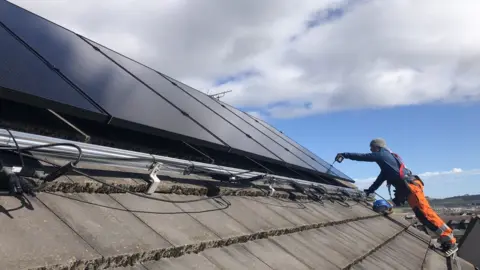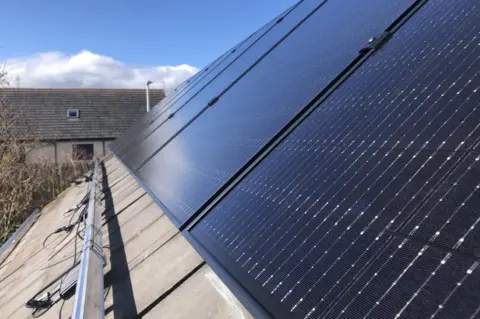Is it time to start producing my own home energy?
Ian Phillips admits to feeling smug about installing solar panels at his home in Aberdeenshire.
He'd been waiting six months for a 6.5kW system to be attached to his garage roof and it was being connected just in time for the dreaded rise in the energy price cap.
"I reckoned I was going to get a lot more electricity and savings than it was going to cost me to install the panels over probably six or seven years," he explained.
But Ian has calculated that higher electricity prices mean there will now be a much quicker payback and that he will be "genuinely saving money" each year.
His "oversized" system cost £7,500, but was covered by an interest-free loan from Home Energy Scotland which he pays back in monthly instalments of about £52 over 12 years.
A smaller system can typically cost about £3,000 to 5,000 and the Energy Saving Trust estimates that in Scotland it could generate the equivalent of 95% of a household's typical electricity usage.
But without an additional battery, matching solar generation with home usage can be difficult. Electricity will sometimes have to be exported to the grid, while at other times it will be topped up by imports.
Solar panels are flying off the shelves, with some customers now having to wait a full year for a photovoltaic (PV) system to be installed.

Jamie Di Sotto, from AES Solar in Forres, Moray, said: "The demand across all markets, from commercial to retrofit, is enormous.
"The driver, largely, is the increase in energy costs but also an awareness of climate change is playing a part."
The latest available figures from the Scottish government show there were at least 70,000 solar installations in Scotland in 2020.
Together they generated 353GWh of electricity, which is roughly equal to Peterhead power station running at full capacity for 12.5 days.
Home Energy Scotland estimates that an average three bedroomed house in central Scotland would save £450 a year under current higher energy prices, and the cost would be paid back in 15 years.
This time last year that saving would have been £340, meaning it would take 19 years to pay for itself.
The Energy and Climate Intelligence Unit (ECIU) estimates that payback time is now a third faster than a year ago.

Another way to save money is by switching to heat pumps, although the figures are less clear cut.
While householders in England and Wales will be able to apply for a £5,000 grant from April, a cashback scheme worth £7,500 is already in place in Scotland.
But the profitable Renewable Heat Incentive, which paid homeowners based on how much heating they produced, is coming to an end.
Andrew Laurie, from Banchory Devenick near Aberdeen, had his ground source heat pump installed just in time to qualify for the old system.
He also admits to feeling "smug" when the cost of heating oil went beyond £1 per litre, but feels it's like being on a fairground ride.
"I go through phases, so when the electricity price went up first I thought I'd made a huge mistake and then when the oil price started to skyrocket I started to feel quite smug.
"I suspect that rollercoaster of emotions will continue for the next wee while too."

His ground source heat pump, working off a bore hole, has cost an eye-watering £27,000 to install - but he believes the incentives will cover that cost over time.
Air source heat pumps are much, much cheaper at around £10,000.
When it comes to running costs, research by the Regulatory Assistance Project (RAP) suggests that the new, higher, energy price cap will significantly change the financial dynamics.
It estimates that the electricity bill for a "very efficient" heat pump will be around £723 compared with £934 for a gas boiler.
The potential savings have grown to £261 per year, compared with just £43 per year under the previous price cap.
For those replacing an oil-fired system, the savings could be as high as £607 per year.

But RAP warns that the savings are contingent on the system being installed well enough to achieve a high efficiency rating. The Energy Saving Trust believes a home replacing an "average" or "best rated" modern gas boiler would see an increase in annual energy bills.
The abolition of VAT on solar PV installations and heat pumps from April is a further saving. It had previously been set at a reduced rate of 5%.
The UK government may also shift green levies from electricity to gas tariffs, which it's promised to consider once bills recede.
Driving an electric vehicle (EV) is another potential way to beat the bills, with diesel peaking this month at £1.79 a litre.
Charging at off-peak rates mean a driver averaging 10,000 miles per year would expect to pay as little as £211 for the energy, according to online calculators from zap-map.
Even on the most expensive price-capped standard variable tariff it would only rise to around £788 from April.
That same mileage in an average sized diesel car would cost up to £1,440 at the highest recent prices.
 PA Media
PA MediaOrkney based EV driver Jonathan Porterfield insists that the economics do stack up.
"Granted, EVs are more expensive now than an internal combustion engine comparable vehicle but when you look at the running costs and the lifetime costs, these are cheaper in the long run," he says.
He says the great thing about electric vehicles is being able to choose energy provider and tariff to maximise the savings based on how the vehicle is used.
But the initial outlays are still a good bit more than the equivalent petrol or diesel vehicle.
Research from the Institute for Transport Studies at the University of Leeds found that even before the price spike, the whole life cost of an EV is cheaper than a petrol or diesel car.
The conclusion is based on depreciation, tax, maintenance, insurance and fuel costs.
Sepi Golzari-Munro, deputy director of the ECIU, said: "What people are finding is that with the gas price rocketing in this last year, anything they can do to cut out gas from their household usage would benefit them.
"Combining the technologies will mean that you can take advantage of the benefits. If you have solar, you have already displaced the electricity that you need to import from the grid. You can then use that to power a heat pump. So, you do make compound savings."
